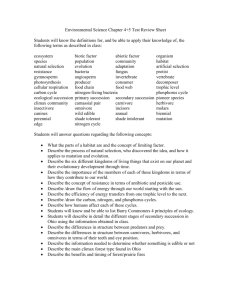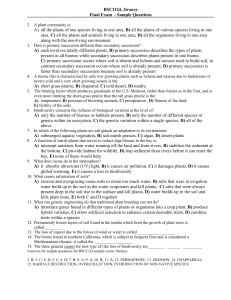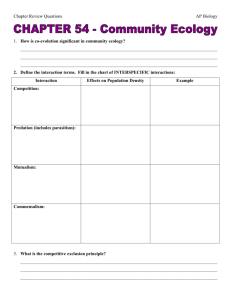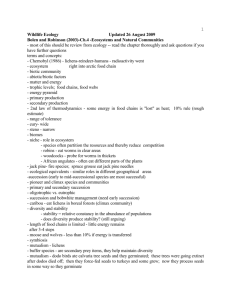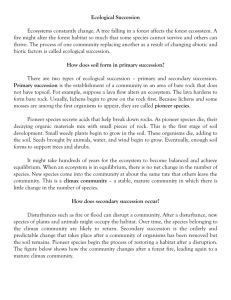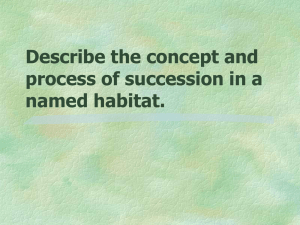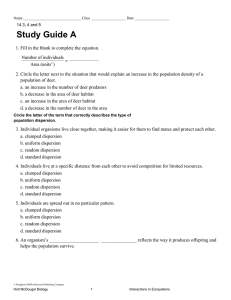Chapter 5: Biodiversity, Species Interactions, & Population Control
advertisement
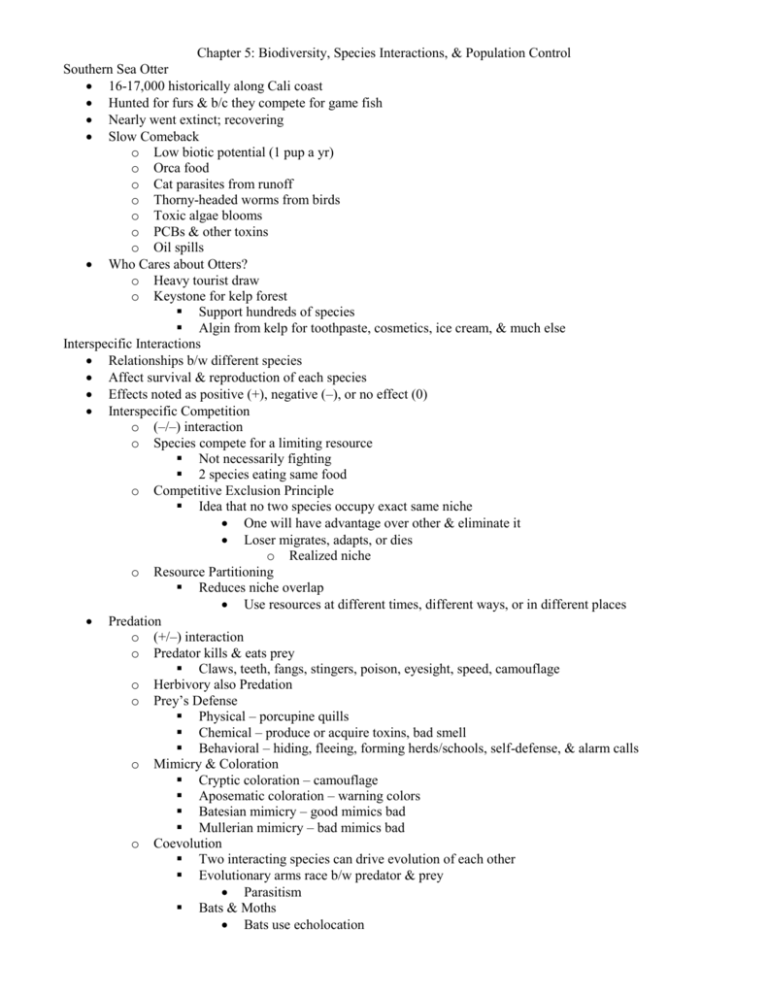
Chapter 5: Biodiversity, Species Interactions, & Population Control Southern Sea Otter 16-17,000 historically along Cali coast Hunted for furs & b/c they compete for game fish Nearly went extinct; recovering Slow Comeback o Low biotic potential (1 pup a yr) o Orca food o Cat parasites from runoff o Thorny-headed worms from birds o Toxic algae blooms o PCBs & other toxins o Oil spills Who Cares about Otters? o Heavy tourist draw o Keystone for kelp forest Support hundreds of species Algin from kelp for toothpaste, cosmetics, ice cream, & much else Interspecific Interactions Relationships b/w different species Affect survival & reproduction of each species Effects noted as positive (+), negative (–), or no effect (0) Interspecific Competition o (–/–) interaction o Species compete for a limiting resource Not necessarily fighting 2 species eating same food o Competitive Exclusion Principle Idea that no two species occupy exact same niche One will have advantage over other & eliminate it Loser migrates, adapts, or dies o Realized niche o Resource Partitioning Reduces niche overlap Use resources at different times, different ways, or in different places Predation o (+/–) interaction o Predator kills & eats prey Claws, teeth, fangs, stingers, poison, eyesight, speed, camouflage o Herbivory also Predation o Prey’s Defense Physical – porcupine quills Chemical – produce or acquire toxins, bad smell Behavioral – hiding, fleeing, forming herds/schools, self-defense, & alarm calls o Mimicry & Coloration Cryptic coloration – camouflage Aposematic coloration – warning colors Batesian mimicry – good mimics bad Mullerian mimicry – bad mimics bad o Coevolution Two interacting species can drive evolution of each other Evolutionary arms race b/w predator & prey Parasitism Bats & Moths Bats use echolocation Moth uses evasive maneuvers when it hears bat Bat changes frequency Moth make clicks to jam bat’s radar Bat stops making noise, listens for moth’s clicks Symbiotic Relationships o Parasitism (+/– ) interaction Parasite feeds on the body of, or energy from host Endoparasites – live within body of host Ectoparasites – live on outside of host Coevolution o Mutualism (+/+) interaction Nutrition/protection Gut inhabitants Nutrition/reproduction Rhino & Oxpeckers Cattle Egrets & Water Buffalo Clownfish & Sea Anemone o Commensalism (+/0) interaction One benefits, other unaffected Bird Nest in Tree Epiphytes (air plants) Live on stems of other trees Population Dynamics Studies size, density, dispersion (distribution), & age structure of populations Dispersion o Environmental & social factors influence spacing of individuals in a population o Clumped Dispersion Individuals aggregate in patches Most common type May be influenced by resource availability & behavior Reproduction (more partners) Hunting (wolves) Food source (plants, fungi) Protection (fish) o Uniform Dispersion Individuals are evenly, uniformly, distributed May be influenced by social interactions Territoriality – animals defend area against others Plants secrete chemicals to prevent crowding o Random Dispersion Position of each individual is independent (random) of other individuals Least common Occurs in absence of strong attractions or repulsions Population Size o Effected by… Resource availability Temperature Disease organisms Harmful chemicals Arrival or disappearance of competitors o Determining Population Size Count all individuals in population Sampling techniques Count individuals in several different areas, calculate density, then total population Count nests or tracks in area, calculate density, then total population Mark Recapture Method Capture & mark a random sample of individuals Release; allow time for mixing Capture 2nd set of individuals, count number marked Calculate total population Practice Problem Dolphins – 180 marked initially, 44 recaptured, 7 marked o Total Population = 1131 M1 /N = M2 /n (or N = M1 n/ M2) o M1 = # originally marked o N = total population size o M2 = # marked in recapture o n = total # recaptured o Population Changes Birth Rate Death Rate Immigration Rate – coming Emigration Rate – going Total Population change = (Birth + Immigration) – (Death + Emigration) Natural Population change = Birth - Death Example Birth = 25/1000 Immigration = 10/1000 Death = 10/1000 Emigration = 5/1000 Total Growth Rate per year? o 20/1000 If total population = 100,000; how many new individuals in next year? o 2,000 Example Birth = 24 per 1,000 Death = 8 per 1,000 What is natural annual percent increase? o 16 per 1,000 or 1.6% o % means 100 in denominator Population Age Structure o Proportion of individuals at various ages Pre-reproductive age Reproductive age Post-reproductive age Biotic Potential o Capacity for population growth under ideal conditions o Intrinsic Rate of Increase (r) Max rate at which population would grow w/ unlimited resources o High r values: Reproduce early in life Short generation times Reproduce many times in life Large # of offspring each time Environmental Resistance o Combo of all limiting factors of population growth o Carrying Capacity (K) Max population a habitat can support w/o degradation Growth Curves o Logistic Growth (S curve) Fast growth; then fluctuates around (K) o Exponential Growth (J curve) No limitations o Thomas Malthus (1766-1834) An Essay on the Principle of Population (1798) Population growth will lead to starvation, war, disease Death rates will check population unless birth rates lower (K) & Population Crash o Reproductive time lag leads to overshoot of (K) o Dieback occurs; can also lower (K) o (K) can change (seasons, rain drought, competitors) Survivorship Curves o Type I – high survival rates when young & decrease sharply when old o Type II – survival rates are equivalent regardless of age o Type III – high death rate when young & survival rates higher when older r-selected Species o Opportunists; reproduce & spread fast Small size, fast growth, short life, many offspring, no parental care K-selected Species o Competitor; live in places near max (K) Large size, slow growth, long life, few offspring, parental care, strong competitor Small populations & Genetic diversity woes o Genetic Problems Increase frequency of genetic defects Less diversity to adapt More susceptible to disease o Examples Founder Effect Few individuals from a population colonize a new habitat Demographic Bottleneck Few individuals survive a catastrophe Genetic Drift Random changes in gene frequency Some individuals may breed more often than others; their genes become more prevalent ‘Flip a coin’ Inbreeding Close relatives mate Lines up recessive genes Greatly increases risk of genetic abnormalities o Minimum Viable Population Size Minimum size of population needed for long term survival of a species These ideas w/ island biogeography model help to predict Population Density o Density Dependent Factors Larger effect w/ higher density Predation Parasitism Disease transmission Competition for food, space, mates o Density Independent Factors Density doesn’t matter Normally abiotic factors Floods Hurricanes Fire Pollution Habitat Destruction Severe cold/warm weather Human Controls o Bubonic plague (1300s) Bacteria from rat fleas o Ireland (1845) Potato rot from oomycete o AIDS Viral STD White-Tailed Deer o Deer in U.S. o 1900 – habitat destruction & uncontrolled hunting o 1920s-30s – laws to protect deer; wolves & mountain lions nearly eliminated o Current – 25-30 mil. deer Lyme disease carrier Deer-vehicle accidents (1.5 mil.) Eating garden plants & shrubs o Hunt ‘em down o Hunted in rural areas More doe tags given to lower #s o Suburbs? Can’t have gun nuts running around Hired professional archers Fence in yards Spray predator scent Birth control & sterilization? Ecological Succession Gradual change in community composition in a given area over a long period of time Just a GENERAL pathway Two types… o Primary Succession Begins in lifeless areas w/ no soil Areas such as… Lava Flow Receding Glacier Abandoned Road/Parking Lot Takes a long time b/c no soil Rock breaks down & releases nutrients by… o Physical weathering – water o Chemical weathering – rain water & atmospheric compounds o Biological weathering… Early Successional Plants o Pioneer species attach to weathered rocks Arrive as seed/spore brought by wind or animal Lichens – mutualism b/w alga (photosynthesis) & fungus (protection) Mosses – primitive plants o Pioneers Create Soil Trap wind blown particles/detritus Secrete mild acids that further breakdown rocks (lichens) o o o Mosses trap water like a sponge Waste & dead matter from pioneers After 100s-1000s yrs; soil may be thick & fertile enough for… Midsuccessional Plants o Herbs, grasses, & low shrubs Create shade; kills off lichens & mosses o Trees adapted to area arrive Fast growing, shade intolerant Climax or Late Succession o Shade tolerant seedlings arrive Tall trees w/ long life spans o Mid-successions dieoff b/c seedlings shade intolerant Secondary Succession Occurs after disturbance, removal, or destruction of ecosystem Still has soil left Beginning Anew Seeds germinate that remain from before disturbance, or are brought from elsewhere Much faster than primary b/c soil already present Succession Setbacks Fires Hurricanes Clear-cutting of forests Plowing of grasslands Invasive species Prescribed Burning Natural habitat not always climax community Periodic fires can keep out late succession plants Gets rid of fast burning plants Small weeds & scrub brush Maintains high native biodiversity Florida Long Leaf Pine 150 yrs to reach 100+ feet tall adult Live up to 500 yrs Very Fire Resistant o Thick layers of bark o Leaves occur high off ground o Needle-like leaves o Leaves contain tannic acid Red-Cockaded Woodpecker, Gopher Tortoise, Indigo Snake
